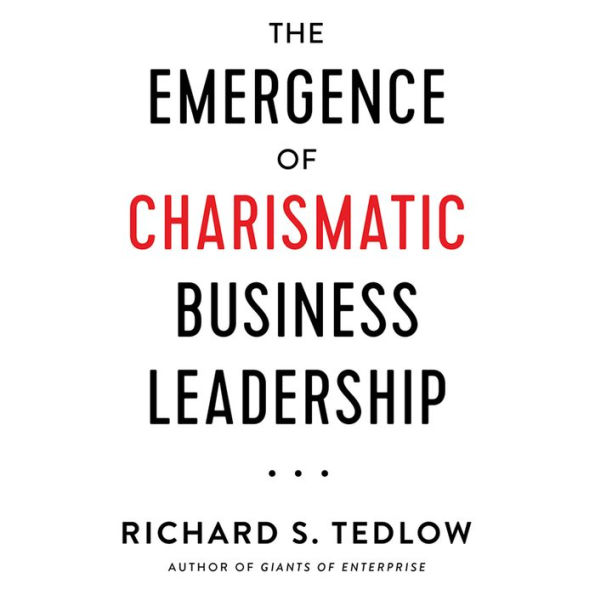
The Emergence of Charismatic Business Leadership
Narrated by Richard S. Tedlow
Richard S. TedlowUnabridged — 11 hours, 25 minutes

The Emergence of Charismatic Business Leadership
Narrated by Richard S. Tedlow
Richard S. TedlowUnabridged — 11 hours, 25 minutes
Overview
What makes a truly successful leader? Whether you're the manager of a small team or the CEO of a global brand, learn how leading business figures have developed their leadership skills and management styles to become more effective leaders.
In The Emergence of Charismatic Business Leadership, Harvard Business School Emeritus professor Richard S. Tedlow examines how the role of the business leader has changed since World War II. A handful of individuals have helped transform the face of modern-day leadership, making charisma essential to the role. But what does this change mean for the future? How can you become the next world-changing leader?
In order to answer these questions, we must look at leaders like Oprah Winfrey, Elon Musk, and Steve Jobs. Today, Jobs is considered to be the model of the modern charismatic business leader, but it would have been inconceivable for him to be the CEO of a major company in 1955, the year he was born. Though all three of these pioneers were once outsiders, they each found success by innovating their management style and using their charisma to champion their clear and ambitious vision.
Through Tedlow's in-depth accounts of modern business history, we see how charismatic leadership enables the creation of revolutionary new products-the battery electric vehicle, the smart phone-and makes it possible for former outsiders to attain power and influence. However, the book also considers the careers of people who used their charisma to mislead, such as Jeff Skilling of Enron and Elizabeth Holmes of Theranos.
Charisma can get you far, but if not accompanied by genuine character, it will lead you astray. In this thorough examination, Tedlow shows how charismatic figures have developed the leadership skills and management tools necessary to oversee a successful business and become a charismatic business leader.

Product Details
| BN ID: | 2940192470589 |
|---|---|
| Publisher: | Brilliance Audio |
| Publication date: | 09/14/2021 |
| Edition description: | Unabridged |
Read an Excerpt
Contents
PART I
The Great Transformation
Chapter 1—Steve Jobs, a Life in Three Acts. Act One: End and Beginning
Chapter 2—What Is Charisma?
Chapter 3—American Business Leadership in the Postwar World: General Motors as a Case Study
Chapter 4a—The Business Executive of the 1950s in Fiction: The Man in the Gray Flannel Suit
Chapter 4b—The Business Executive of the 1950s in Fact: The Organization Man
Chapter 5—Edwin H. Land: The Charismatic Business Leader Before His Time
PART II
1975 to 1995: The Transitional Era
Chapter 6—Resilience: The Lee Iacocca Story
Chapter 7—“All Things Not Trump”: Sam Walton, Merchant
Chapter 8—Company and Crusade: The Story of Mary Kay Ash
Chapter 9—Manager Versus Money: The Rise of the Market for Corporate Control
PART III
The Rise of the Superstar CEO
Chapter 10—The Accidental Billionaire
Chapter 11—Oprah Winfrey: The Magnetism of Misery
Chapter 12—Elon Musk: Charisma at the Edge of Reality
Chapter 13—Steve Jobs: Triumph at Apple
Chapter 14—Charisma and Corruption: Two Tales From Recent History
Chapter 15—Charisma in American Business History: Yesterday and Today
PART I: The Great Transformation
In the years following World War II, the biggest American businesses were faceless bureaucracies. This characteristic is captured by their names: General Motors, Standard Oil, United States Steel, and so forth. If I told you the names of the chief executive officers of these firms in, say, 1955, you would not recognize them. Indeed, few people in 1955 knew who they were. I choose 1955 because Time magazine selected the CEO of General Motors as its “Man of the Year” then. He was chosen because of the position he held, not because of the person he was. The job had a man rather than the man having a job.
In 1956, William H. Whyte published a brilliant book entitled The Organization Man. According to Whyte, the key to success in the large American company was “fitting in.” He cites, for example, a documentary about the research laboratory of a major chemical corporation in which the narrator proudly observes, “No geniuses here; just a bunch of average Americans working together.”[1]
The contrast to our world today could not be more striking. The names of large companies now often have personality: Amazon, Apple, Facebook, etc. The names of the people who are leading or who have recently led these corporations are known all over the country and indeed the world: Bezos, Jobs, Zuckerberg. The shunning of genius and the celebration of the average are inconceivable at these companies.
This great transformation has been essential in order to sustain the vibrancy of the American business world. Why has it taken place? What made it possible? An important part of the answer to these questions is the rise of charismatic business leadership.
There were charismatic business leaders in the 1950s and 1960s, just as there are CEOs today who are not charismatic. We are describing a general tendency away from the CEO as the chief mechanic of the business who kept the wheels of the company turning while working out of the public gaze to the CEO as a man or woman with a mixture of charm, guile, brilliance, and cruelty who remakes the industry and in some cases society as a whole and in the process becomes a celebrity.
What is charisma? It is a mercurial word for a mercurial concept. By looking at leaders who have it and those who do not, we will try to encapsulate its meaning. We will begin with Steve Jobs, who is invariably described as charismatic without that adjective ever being defined.
[1] William H. Whyte, The Organization Man (Philadelphia: University of Pennsylvania Press, 2002 – originally published in 1956) p. 224.
Videos

